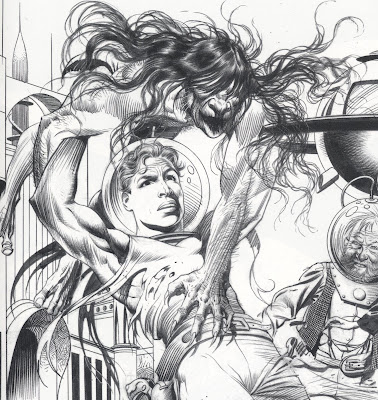
Feliks Topolski (1907-1989) traveled the world, illustrating the great places and events of his day.
Born in Poland, Topolski set out for adventure at an early age. He made his way to Britain, the US, the Middle East, Canada, Ireland, France, India, Australia, Italy, Argentina, Switzerland, Denmark, Norway, Germany, Brazil and Portugal. Wherever he went, he kept a visual diary of the things he witnessed. His drawings of exotic street bazaars, ancient temples and crowded cities were collected in highly popular books.



During World War II, Topolski became famous as one of the great war illustrators, working on the front lines in Russia, China, Burma, India, Palestine, Africa, Egypt, Syria and Italy. He was in London to record the Battle of Britain, and in Germany to record the collapse of the Nazi regime. He witnessed first hand the freeing of the concentration camps. Here is a wonderful detail of looters making off with plunder in the streets of Bergen:

Born in Poland, Topolski set out for adventure at an early age. He made his way to Britain, the US, the Middle East, Canada, Ireland, France, India, Australia, Italy, Argentina, Switzerland, Denmark, Norway, Germany, Brazil and Portugal. Wherever he went, he kept a visual diary of the things he witnessed. His drawings of exotic street bazaars, ancient temples and crowded cities were collected in highly popular books.



During World War II, Topolski became famous as one of the great war illustrators, working on the front lines in Russia, China, Burma, India, Palestine, Africa, Egypt, Syria and Italy. He was in London to record the Battle of Britain, and in Germany to record the collapse of the Nazi regime. He witnessed first hand the freeing of the concentration camps. Here is a wonderful detail of looters making off with plunder in the streets of Bergen:

Here is an excellent drawing of Jordanian soldiers standing guard:

He drew portraits of world leaders such as Gandhi, Winston Churchill and Bertrand Russell

One thing I particularly like about Topolski is the care he devoted to drawing people who were standing around waiting aimlessly.
Traveling under primitive wartime conditions, Topolski saw a lot of people sitting around waiting; waiting for food, waiting because transportation broke down, waiting for visas, waiting in prison camp yards... progress had come to a halt, and it seemed like most of the world spent most of its time waiting in lines.
Rather than succumb to mind numbing boredom, Topolski found the inspiration to take out his pencil and draw the people sitting around. He made thousands of drawings of such groups all around the world, but you can tell from the following examples that Topolski remained alert and observant, shrewdly capturing in line the identity and characteristics of each group.


He drew portraits of world leaders such as Gandhi, Winston Churchill and Bertrand Russell

One thing I particularly like about Topolski is the care he devoted to drawing people who were standing around waiting aimlessly.
Traveling under primitive wartime conditions, Topolski saw a lot of people sitting around waiting; waiting for food, waiting because transportation broke down, waiting for visas, waiting in prison camp yards... progress had come to a halt, and it seemed like most of the world spent most of its time waiting in lines.
Rather than succumb to mind numbing boredom, Topolski found the inspiration to take out his pencil and draw the people sitting around. He made thousands of drawings of such groups all around the world, but you can tell from the following examples that Topolski remained alert and observant, shrewdly capturing in line the identity and characteristics of each group.


The posture and clothing of the Russian soldiers in their thick coats look entirely different from the displaced persons, who look entirely different from the German POWs.


Those who see with the eyes of an artist, whose hand itches to draw, find opportunities for excellence even when surrounded by tedium.






































